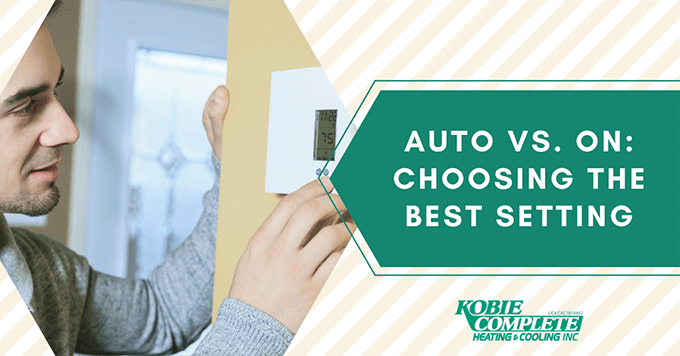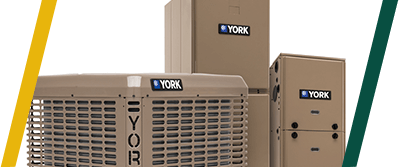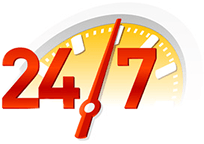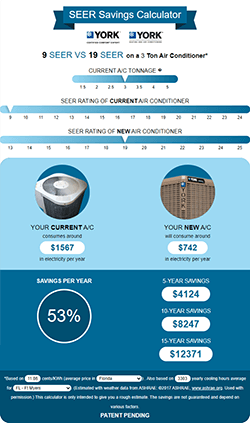
What you don’t know about your air conditioner might be costing you. Especially when it comes to choosing between your thermostat’s AUTO and ON settings. Making an informed decision about these settings will impact your comfort and electric bill.
AUTO and ON Defined
Let’s start with the basics. All single stage air conditioning systems come with two main thermostat operation modes – AUTO and ON. (“Single stage” means that the air conditioner is only capable of running at one speed. Either it’s cooling your home at full blast, or it’s off.)
Every air conditioner is equipped with a blower, or fan, which is a motorized part that circulates the heated or cooled air throughout your space. When your air conditioner is set to AUTO, both the compressor (the part that cools / heats the air) and the fan (the part that moves the conditioned air) cycle on and off simultaneously when the temperature reaches the thermostat’s set point. When your air conditioner is set to ON, the fan runs continuously, even when the cooling / heating cycle is off.
Now that we’ve covered the nuts and bolts, let’s move on to the pros and cons of AUTO and ON. First, let’s look at energy efficiency.
AUTO vs. ON
AUTO is More Energy Efficient than ON
The ON setting, because the fan is constantly running, uses more electricity than AUTO. One FPL (Florida Power & Light) Expert estimates that using the ON setting would cause the fan to run 200 hours longer per month in a home where the air conditioner would normally cycle off 30% of the time. This would cost the homeowner $8 more per month.
AUTO Offers Better Humidity Control than ON
Humidity control is an important function for air conditioners in the Sarasota and Charlotte county area. The AUTO and ON settings influence how effectively your air conditioner dehumidifies.
To understand how your air conditioner removes humidity from the air, think about how beads of condensation form on a glass of ice water on a warm day. In similar fashion, during your air conditioner’s cooling cycle, air moves across the cold surface of the evaporator (indoor) coil, causing moisture to collect and forms droplets.
In AUTO mode, when the system cycles off and the coil begins to warm up, these moisture droplets drip into the drain pan and flow out of your home. However, in ON mode, when the cooling cycle is off, the fan is still running. This means that as the coil warms up, the air flowing over it causes some of the moisture to evaporate and return into your home.
Thus, AUTO mode is better than ON mode in supporting proper dehumidification. But it is important to note that the thermostat setting is not the only influencing factor in how well your AC removes humidity. Other factors also weigh in, such as the size of your air conditioner in proportion to your home’s square footage.
ON Improves Air Filtration & Circulation vs. AUTO
When it comes to air filtration, ON has the upper hand. In ON mode, the blower perpetually circulates air through your AC filter. This allows the filter to extract more particulate matter like dust, pollen, dander and other allergens. Constant air circulation also boosts the effectiveness of some whole-house air filtration systems.
Of course, increased filtration means you’ll have to change or clean your filters more often. But this is only a small downside if you are concerned about indoor air quality for health reasons.
ON Can Help Even Out the Temperature in Your Home
Additionally, the increased air movement in ON mode can eliminate hot or cold spots in your rooms. You might also stay more comfortable between your air conditioner’s heating or cooling cycles thanks to the air movement. Of course, you can achieve a similar effect with ceiling fans or portable fans.
Variable Speed Systems Combine the Best of Both AUTO and ON
To enjoy the benefits of both the AUTO and ON settings, consider upgrading your single stage air conditioner to a variable speed system. Variable speed systems dynamically adjust the airflow and cooling to maintain a consistent temperature, eliminating temperature swings between cooling cycles. This means that the system runs almost constantly, but it is also extremely energy efficient because it is able to run at a lower capacity and does not cycle on and off nearly as often. Thus, variable speed air conditioners are able to provide continual filtration, proper humidity control, and even temperatures, all while achieving a high level of energy efficiency.
In Summary
- We recommend setting your thermostat to AUTO for the best balance of energy efficiency and comfort.
- If you are concerned about indoor air quality or suffer from allergies, the ON setting’s increased air filtration could be beneficial.
- Consider upgrading to a variable speed air conditioner for optimal energy efficiency, filtration, temperature balance and humidity control.
Get a Free Quote on a New Air Conditioner
Did the benefits of a variable speed air conditioning system pique your interest? If you live in the Englewood, North Port, Venice, Punta Gorda or Sarasota, Florida area and you’re interested in upgrading your air conditioner to a more energy efficient model, contact us for a free, no obligation quote! Call us today at (941) 474-3691 or fill out this form:
Sources:
Spence, Tiffany. “A/C Fan “On” or “Auto?” Which Uses Less Energy?” FPL Blog, Aug. 30, 2016
Bailes, Allison. “Don’t Set Your Air Conditioner Thermostat Like This” Energy Vanguard, Jun. 6, 2011
Last Updated: May 27, 2021










